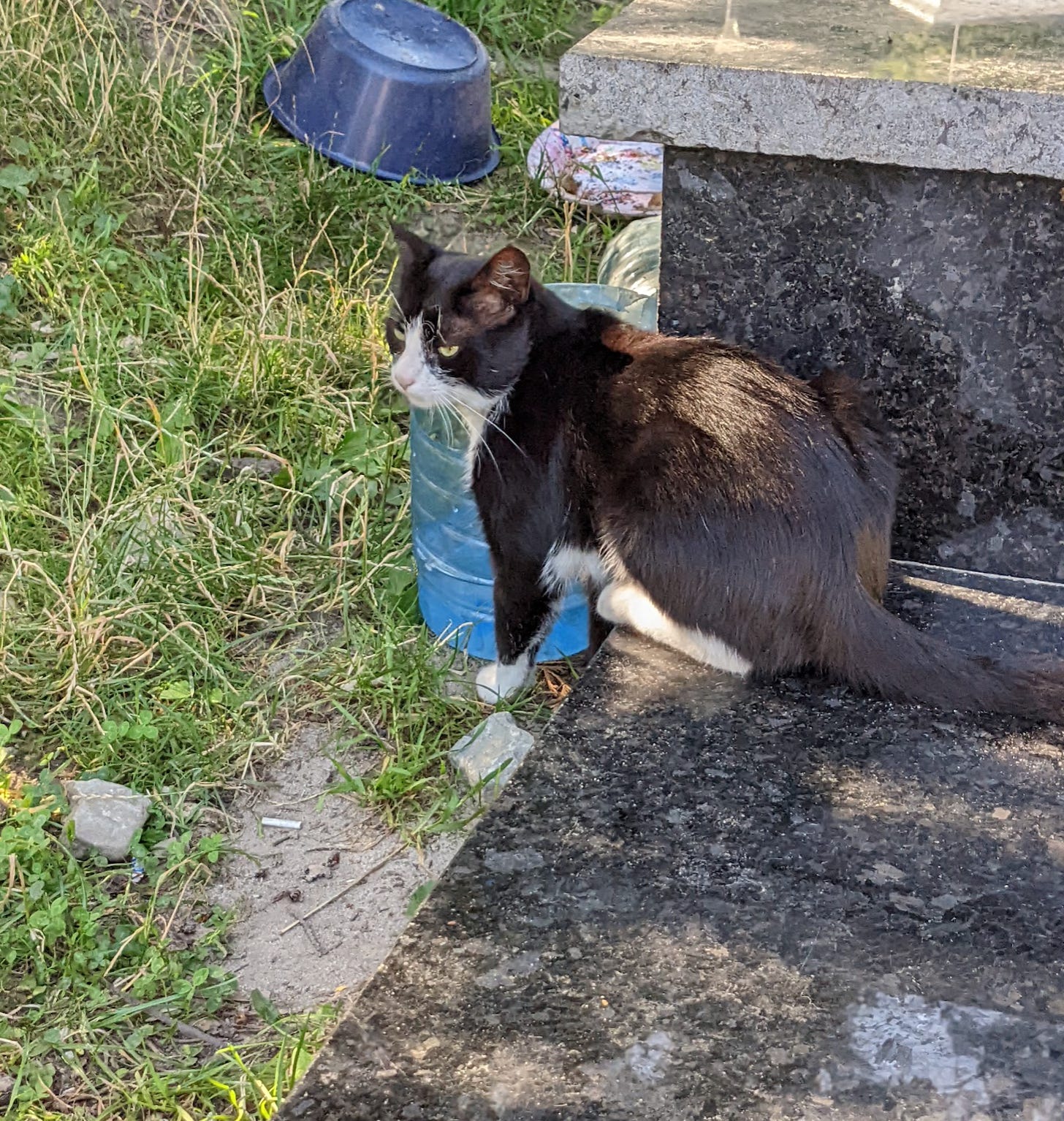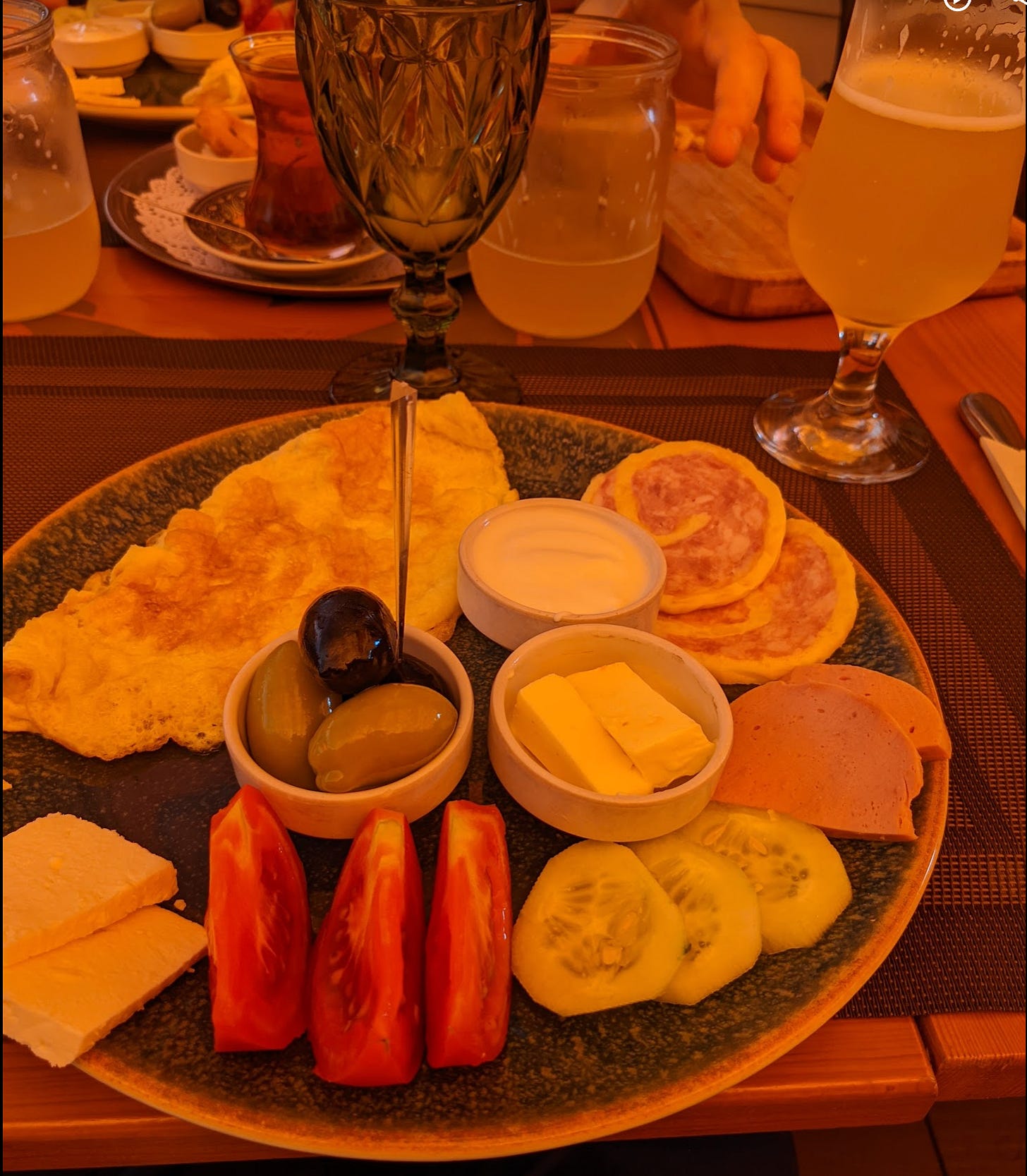I recently travelled with a friend to Ukraine for a specific purpose - to meet with and support a friend and colleague and his family. He is unable to leave the country so we decided to surprise him by visiting. My old journalism habits also kicked in, so I decided to write about the experience.
It was with a little trepidation that me and Jakob approached the border crossing at Medyka on a blazing hot summer’s day three weeks ago. We had agreed to visit Ukraine in advance of a Kherson counteroffensive, which we expected to begin in mid-August and could incur retaliatory missile attacks by Russia. So we felt the risks of travelling were at the lowest in several months. The offensive ultimately began on August 28th.
Our driver, Viacheslav, had collected us two hours earlier at our hotel in Krakow. We had spent the morning driving along Polish motorways heading east before taking a side road to Przemyśl. The plan was for Viacheslav to drop us at the border crossing, whereupon we would walk across the border crossing with luggage in tow, before meeting our second driver Volodoymr (or “Vlodko”) on the other side.
Our purpose? To visit a friend and colleague and his family who live in the town of Truskavets. He has been unable to leave the country since the onset of the war and the imposition of martial law in February.
For much of the drive Viacheslav had told us the situation on the ground in Ukraine and what sort of work he’d been doing. On a few occasions he became understandably vocal and angry about he felt towards Russia, and in particular the country’s leader Vladimir Putin. We listened, and agreed.
The motorway puts you very close to the airport at Rzeszów - the centre of Western weapons transfers to Ukraine. I remarked on it as we passed it and Viacheslav retorted, praising the US in particular - yes the shipments fly in here and then go over the border. “Mostly at night,” he said.
I also commented on the excellent Polish motorways and their rather extensive noise reduction barriers - he laughingly noted that it won’t be the same over the border. But maybe someday, he said wistfully, Ukraine will be in the EU and better roads will be funded and built.
The border crossing at Medyka was not busy - a smattering of people of all ages coming from Ukraine into Poland, carrying an assortment of luggage with them. Some stopped at the tents setup by international aid agencies - who offered free bottled water and guidance. Medyka is not a primary EU border crossing - but had seen its fair share of refugees since the onset of the war in February.
We said our goodbyes to Viacheslav as he gave us our luggage and wished us good luck on our journey. He said Vlodko was already on the other side waiting for us.
We strolled past people on the other side of the fence, feeling somewhat voyeuristic looking at people walking with their lives assembled in their luggage. I felt a little guilty at going the opposite direction - entering the country they were fleeing - for reasons beyond their control.
After we cleared the Polish “exit” border we walked towards the Ukrainian border. A broken bottle of red wine greeted us at the sweltering border checkpoint building as soon as we got in the door - two Ukrainian border officials hurriedly tried to mop it up as we began to queue to have our passports checked and stamped.
My colleague Jakob went first. The burly Ukrainian border guard looked at him with some suspicion. She glanced at his passport and then at him again, before barking something at him in Ukrainian. Another official strolled over and began to translate as Jakob - himself fluent in German, English and Romanian, looked somewhere between puzzled and panicked.
“She is wondering what the purpose of your visit is,” the older male Ukrainian border official whispered to Jakob. “I think she was puzzled as to why a Romanian is crossing from Poland.” Jakob later said. Jakob said that he was visiting a friend in Truskavets and planned to stay only a few days. The official repeated this in Ukrainian to the lady border official. She stamped his passport.
I wondered as I approached her what she would make of an Irish passport following a Romanian one. She glanced at me and my passport photo and stamped, clearly understanding we were travelling together.
We walked from the border building into the Ukrainian side of the border building and noticed a queue of mothers and their children queuing to enter the same building from the opposite direction- albeit on the other side of a 10-foot fence from us. In the blazing sunshine, two babushkas had paused on the path to the building drink some water and take a breather as they left their country.
We entered Ukraine.
We walked towards the long line of cars parked - including many Ukrainian drivers asking us in Ukrainian if we wanted a ride anywhere - until we eventually found Vlodko. “Gav,” he shouted as he saw me, recognising me from my WhatsApp picture. I only realised then that the reason Viacheslav and him had been calling me “Gav” all morning and not “Gavin” was that’s what I called myself on my WhatsApp profile but had forgotten. The entire trip had been arranged over WhatsApp - I didn’t bother correcting him.
Vlodko bundled our luggage into the boot and quickly turned on the air conditioning to mitigate the sweltering heat. Vlodko had run a travel/tourism agency before the war, and had adapted his business to cater for people like us - in need of transport into and out of Ukraine through means other than the intermittent train service between Poland and Lviv. He welcomed us to Ukraine and confirmed our destination. “Truskavets?”, he said. “Yes please,” I replied, and we he hit the road.
Our first indications that we were in a country at war was passing the occasional hastily prepared sandbagged checkpoint, with a Ukrainian serviceman standing guard. During the journey we would drive by more heavily guarded military installations, with Ukrainian soldiers standing guard. You will also notice billboards with patriotic ads imploring people to support the army.
Before long, Vlodko was telling us of the history of this part of Ukraine, while telling us of his experiences over the previous 5 months. Our route took us through several towns - Mostyska, Sambir and Drohobych.
Part of the history of this region at the northern end of the Carpathian mountains is oil, kerosene and salt mining. Salt mining was a big employer in the region. Vlodko reminded us that kerosene - based on petroleum - had been developed in the 1850s in Lviv by Vienna-educated Polish chemist Ignacy Łukasiewicz and his partner, at a time when western Ukraine, southern Poland and many other regions formed part of the Austro-Hungarian empire.
Though rumours suggested Łukasiewicz was really trying to make alcohol from petroleum - he ended up accidentally with kerosene and made a fortune from his discovery - and opened the world’s first oil refinery in Jasło in Poland (120km from our location) in 1856.
The Austro-Hungarian legacy exists everywhere in this part of Ukraine - most notably in the Oblast’s capital Lviv. Whatever survived destruction in the Soviet era is still very much in the design aesthetic you would see in Vienna, Prague, Krakow or Bratislava - similarly for northern Romania (a newsletter for another day).
As we approached Truskavets, Vlodko inquired after our reason for visiting this particular town. “We have a friend and colleague there so we’re going to surprise him and his family, and bring some gifts,” I blurted out. “Wonderful,” he replied. “Do you know of the history of Truskavets, will you be getting some spa treatments and relaxing while there?”. “I’ve researched a little, but please…,” I said.
Vlodko began telling us about the history of the Truskavets resort - the key ingredient being the almost mythical mineral waters. In the Soviet era workers would be sent to the resort town to recover from whatever ailed them, and be prescribed in particular the ingestion of the famous ‘Naftusya’ water, the history of which dates back to 1836.
Vlodko got us to our hotel in Truskavets after a minor interaction with a raising bollard for access to a specific street. He offered us some fresh plums from his boot and bid us an enjoyable stay in the town.
We surprised our colleague with news of our arrival, and met him for an evening stroll around town.
On our first morning in Truskavets we drank some Naftusya water while visiting Бювет №1, the main public place for tapping into it. It comes out as warm water, smelling strongly of sulphur. You pay for entry and then for cups to fill with the water - while specific flasks designed to drink from are on sale. I struggled not to vomit on the first ingestion - but you learn not to smell while you drink it.
Of course Ukraine is also a country of cats, and Truskavets was no different. This one was sampling some of the mineral water:
After drinking your ‘Nafta’ water you are advised to take a walk through the neighbouring park. Some believe that you must take a specific route, along with touching or embracing specific trees in order for the water to work correctly on your body. This route leads you to the glycerin fountains.
The advice here is to cover your skin in the water as it is supposed to be excellent for your skin health - being careful not to wipe it off but instead to let it dry on your skin naturally.
We continued through the park - stopping to admire several works of art - before returning to the hotel via a nice restaurant for an omelette and some tea.
Of course along the way you might see some abandoned Soviet-era hotels, such as this:
In the next newsletter I will write about catching a train to Lviv, visiting Lviv and a return leg to Poland.














Fascinating stuff Gavin.